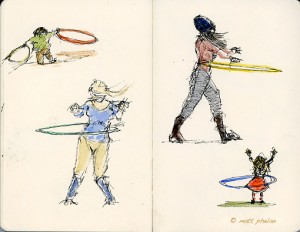Today’s interview is with award winning artist Matt Phelan. He recently had his first graphic novel released and was gracious enough to spend some time answering questions about his art and his career path.
—
When did you get started illustrating books for children? What did you do before?
I began illustrating full-time in 2004. Just prior to that, I was an editor and copywriter for the admissions office of a university.
You have a new book out The Storm In The Barn. This is the first book you also wrote. Please tell us a bit about it.

The Storm in the Barn is a graphic novel set during the Dust Bowl era. It is part historical fiction, part fable, and part supernatural thriller.
The Storm In The Barn is a graphic novel. How does illustrating a GN differ from a picture book?
Apart from the size and sheer volume of drawings, the real difference is in how you are manipulating individual panels to guide the reading experience.
You illustrated The Higher Power of Lucky, which went on to become a Newbery Medal award winner. How has this changed your career?
I think, within the publishing industry at least, my name recognition shot up considerably on the day that was announced.
The Higher Power of Lucky is a novel. Is illustrating a novel in black in white much different than illustrating a picture book? How do you approach the differences?
The main difference is that with a novel you are adding accents to a scene, trying to enhance a particular moment, or add a moment to complement the text. With a picture book, you are doing that, but you are also responsible for creating the entire world of that book.
What are you working on right now? Do you have any other books or art projects you’d like to talk about?
I am illustrating a new picture book by Ann Stott (author of Always), the third Lucky book by Susan Patron, and my next graphic novel which is called Around the World and is based on three true stories of 19th-century globetrotters.
Do you do non-children’s book art (licensing, fine art, etc.) or art just for fun? Is that art similar or different from your children’s book art?
I draw as often as I can and I wish I took more time to just draw for the sheer pleasure of it. Many of my non-book drawings wind up on my Planet Ham sketch blog. I haven’t done any licensing work or “fine” art.

Do you illustrate full time? If not, what else do you do?
I am fortunate enough to do this full time.
When illustrating picture books do you include a visual storyline not mentioned by the text or include animals or people you know?
It’s always nice to add something to a picture book, something the author may not have even thought of (as long as it is true to the book). I added a dog as a sort of comic foil to the picture book Always, but he wasn’t based on any real animal. Some friends have noticed similarities to some real people in my books, but I never do that intentionally.
On your blog (http://planetham.blogspot.com) you do a series called Monkeys of the World. What was the inspiration for that?
That was actually originally done as a gift for a friend (it was a calendar). I just thought the idea of showing the indigenous monkeys of such places as Michigan and The Hague was funny.

Do you have a favorite color or palette?
I prefer a more muted palette when it’s appropriate, but I let the book dictate what I should use.
What is your favorite medium to work in? Have you always worked in this media? If not, why did you switch?
I generally use watercolor which is fascinating and frustrating. I used pastel pencils for Very Hairy Bear and found that to be a lot of fun. I hope to have a chance to use them again.
Do you use models/source pictures or do you draw from your memory/imagination?
I’ll occasionally use reference photos to see what an object or place looks like, but then I’ll filter it through my own style. I don’t use models.
What gets you through an illustration when you’re stuck for inspiration?
If I’m really stuck, I’ll go for a walk, think about a different problem, or look at books or other general forms of inspiration. But I’ll get back to the problem soon. The solution always involves just sticking with it.
If you could illustrate any writer’s new work, who would it be?
I probably wouldn’t turn down a book by Neil Gaiman.
What one piece of advice would you give to an illustrator just starting out?
Focus on making your portfolio the best it can possibly be. That’s the one thing you have complete control over. It’s also the one thing that will get you work.
—
Thank you for spending time with us, Matt.

 RSS - Posts
RSS - Posts
What a great interview, Wendy, a real treat!
I remember when I first saw the illustrations in “The higher power of Lucky” and being very impressed. He has a great style and a lot of talent.
Thanks again!
I actually bought two signed copies of “The Higher Power of Lucky” for two different friends because I was drawn to the illustration on the front–beautifully & gracefully drawn. Matt Phelan makes drawing look effortless when of course we all know that to get to that stage, one must spend years getting there. I enjoyed the interview!